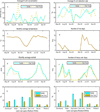Influence of Climate Extremes and Land Use on Fecal Contamination of Shallow Tubewells in Bangladesh
- PMID: 26844955
- PMCID: PMC4775353
- DOI: 10.1021/acs.est.5b05193
Influence of Climate Extremes and Land Use on Fecal Contamination of Shallow Tubewells in Bangladesh
Abstract
Climate extremes in conjunction with some land use practices are expected to have large impacts on water quality. However, the impacts of land use and climate change on fecal contamination of groundwater has not been well characterized. This work quantifies the influences of extreme weather events and land use practices on Escherichia coli presence and concentration in groundwater from 125 shallow wells, a dominant drinking water resource in rural Bangladesh, monitored over a 17 month period. The results showed that E. coli presence was significantly associated with the number of heavy rain days, developed land and areas with more surface water. These variables also had significant impacts on E. coli concentration, with risk ratios of 1.38 (95% CI = 1.16, 1.65), 1.07 (95% CI: 1.05, 1.09), and 1.02 (95% CI = 1.01, 1.03), respectively. Significant synergistic effects on E. coli presence and concentration were observed when land use and weather variables were combined. The findings suggest that climate extremes and land use practices, particularly urbanization, might promote fecal contamination of shallow well water, thus increasing the risk of diarrheal diseases.
Figures


Similar articles
-
Can Sanitary Inspection Surveys Predict Risk of Microbiological Contamination of Groundwater Sources? Evidence from Shallow Tubewells in Rural Bangladesh.Am J Trop Med Hyg. 2017 Mar;96(3):561-568. doi: 10.4269/ajtmh.16-0489. Epub 2017 Apr 6. Am J Trop Med Hyg. 2017. PMID: 28115666 Free PMC article.
-
High levels of faecal contamination in drinking groundwater and recreational water due to poor sanitation, in the sub-rural neighbourhoods of Kinshasa, Democratic Republic of the Congo.Int J Hyg Environ Health. 2018 Apr;221(3):400-408. doi: 10.1016/j.ijheh.2018.01.003. Epub 2018 Jan 10. Int J Hyg Environ Health. 2018. PMID: 29396027
-
Fecal contamination of shallow tubewells in Bangladesh inversely related to arsenic.Environ Sci Technol. 2011 Feb 15;45(4):1199-205. doi: 10.1021/es103192b. Epub 2011 Jan 12. Environ Sci Technol. 2011. PMID: 21226536 Free PMC article.
-
The Arsenic Contamination of Drinking and Groundwaters in Bangladesh: Featuring Biogeochemical Aspects and Implications on Public Health.Arch Environ Contam Toxicol. 2018 Jul;75(1):1-7. doi: 10.1007/s00244-018-0511-4. Epub 2018 Mar 8. Arch Environ Contam Toxicol. 2018. PMID: 29520432 Free PMC article. Review.
-
The silent threat: Unveiling climate change's water and health challenges in Bangladesh.J Water Health. 2024 Nov;22(11):2094-2112. doi: 10.2166/wh.2024.349. Epub 2024 Oct 18. J Water Health. 2024. PMID: 39611671
Cited by
-
Associations between weather extremes and faecal contamination along pathogen transmission pathways in rural Bangladeshi households: a prospective observational study.Lancet Planet Health. 2025 Jan;9(1):e5-e13. doi: 10.1016/S2542-5196(24)00306-1. Lancet Planet Health. 2025. PMID: 39855233 Free PMC article.
-
Understanding the Impacts of Short-Term Climate Variability on Drinking Water Source Quality: Observations From Three Distinct Climatic Regions in Tanzania.Geohealth. 2019 Apr 18;3(4):84-103. doi: 10.1029/2018GH000180. eCollection 2019 Apr. Geohealth. 2019. PMID: 32159034 Free PMC article.
-
Bacillus Genotypes Exhibit Antagonistic Effects on Lettuce-Based Enterobacter Pathotypes.Curr Microbiol. 2025 Mar 9;82(4):181. doi: 10.1007/s00284-025-04163-8. Curr Microbiol. 2025. PMID: 40057914
-
Effect of Sanitation Improvements on Pathogens and Microbial Source Tracking Markers in the Rural Bangladeshi Household Environment.Environ Sci Technol. 2020 Apr 7;54(7):4316-4326. doi: 10.1021/acs.est.9b04835. Epub 2020 Mar 26. Environ Sci Technol. 2020. PMID: 32167305 Free PMC article. Clinical Trial.
-
Effects of High Temperature and Heavy Precipitation on Drinking Water Quality and Child Hand Contamination Levels in Rural Kenya.Environ Sci Technol. 2023 May 2;57(17):6975-6988. doi: 10.1021/acs.est.2c07284. Epub 2023 Apr 18. Environ Sci Technol. 2023. PMID: 37071701 Free PMC article.
References
-
- Bates B, Kundzewicz ZW, Wu S, Palutikof J. climate change and Water: technical Paper vi. Intergovernmental Panel on Climate Change (IPCC); 2008.
-
- Foley JA, DeFries R, Asner GP, Barford C, Bonan G, Carpenter SR, Chapin FS, Coe MT, Daily GC, Gibbs HK. Global consequences of land use. Science. 2005;309(5734):570–574. - PubMed
-
- Paule MCA, Ventura J-RS, Memon S, Lee B-Y, Jahng D, Kang M-J, Lee C-H. Fecal contamination in Yongin watershed: association to land use and land cover and stormwater quality. Desalination Water Treat. 2015;53(11):3026–3038.
-
- Vernberg W, Scott G, Strozier S, Bemiss J, Daugomah J. The effects of urbanization on human and ecosystem health. In: Vernberg F, Vernberg W, Siewicki T, editors. Sustainable Development in the Southeastern Coastal Zone. Columbia, SC: The University of South Carolina Press; 1996. 1996. pp. 221–239.
-
- Foster SS. Impacts of urbanization on groundwater, Hydrological processes and water management in urban areas. Wallingford, UK: International Association of Hydrological Sciences–Association Internationale des Sciences Hydrologiques; 1990. (IAHS–AISH Pub. No. 198)
Publication types
MeSH terms
Substances
Grants and funding
LinkOut - more resources
Full Text Sources
Other Literature Sources
Medical

